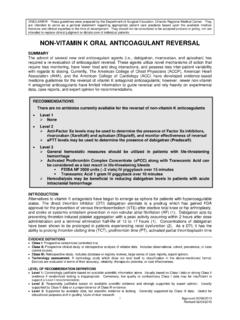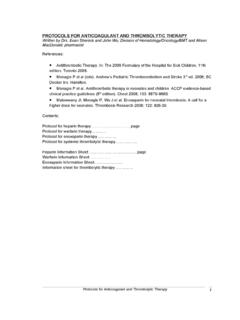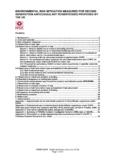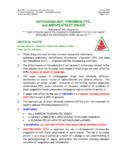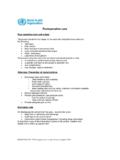Transcription of CONSIDERATION OF THE ENVIRONMENTAL RISK FROM THE …
1 CONSIDERATION OF THE ENVIRONMENTAL RISK FROM THE USE OF BRODIFACOUM, FLOCOUMAFEN, DIFETHIALONE, DIFENACOUM AND bromadiolone Contents Conclusion of the EU Brodifacoum:..3 bromadiolone :..4 Difenacoum:..5 Difethialone:..6 Flocoumafen:..6 Additional Risk from combined Monitoring of the effectiveness of risk mitigation Comparison of the risk posed by the five second generation anticoagulant rodenticides to birds and Risk from primary Risk from secondary Overall Appendix 1. Decision regarding Inclusion in Annex I and Elements to be taken into account by Member States when authorising Appendix 2. Wildlife Incident Investigation Scheme ER SGAR - Health and Safety Executive 2012a Page 1 of 23 CONSIDERATION of the ENVIRONMENTAL risk from the use of brodifacoum, flocoumafen, difethialone, difenacoum and bromadiolone Stakeholder engagement - August 2012 Background Brodifacoum, flocoumafen, difethialone, difenacoum and bromadiolone are all second-generation anticoagulant rodenticides (SGAR).
2 They have all been assessed by Member States (MS) and are on Annex I of the Biocides Product Directive (BPD). As a result of the EU review concern was raised regarding the risk to non-target organisms and these are presented in Appendix 1. Of the points noted in Appendix 1, the one key to this paper and the accompanying paper (see HSE, 2012b1) on risk mitigation measures is: Primary as well as secondary exposure of humans, non-target animals and the environment are minimised, by considering and applying all appropriate and available risk mitigation measures. These include, amongst others, the restriction to professional use only, setting an upper limit to the package size and laying down obligations to use tamper resistant and secured bait boxes.
3 A range of risk mitigation measures are presented in an EU document (Anon 20072) and discussed in HSE (2012b). The EU document states that the choice of specific risk mitigations measures should therefore be deferred to product authorisation stage . It goes on to say that where the use of an anticoagulant presents such a risk of primary and secondary poisoning3 .. the area of use must be confined as much as possible, the authorised use could be limited to use in and around buildings4 or to indoor use only . Outlined below is a CONSIDERATION of the EU review for each active substance as well as additional data considered by the UK. (It should be noted that this paper only covers the risk from the individual active substances, it does not cover any potential increase in risk that may be caused due to resistance.)
4 This is due to this issue not being considered at the EU level.) Conclusion of the EU review ER SGAR - Health and Safety Executive 2012a Page 2 of 23 1 ENVIRONMENTAL Risk Mitigation Measures for Second Generation Anticoagulant Rodenticides Proposed by the UK (HSE, 2012b). 2 Anon (2007) Risk mitigation measures for anticoagulants used as rodenticides. ENV d(2007) 21/03/2007. Available at 3 Primary poisoning in this instance refers to the consumption of the bait itself, whilst secondary poisoning refers to the consumption of treated rats, mice and other organisms by predatory and/or scavenging birds and mammals. 4 'In and around buildings' shall be understood as the building itself, and the area around the building that needs to be treated in order to deal with the infestation of the building.
5 This would cover uses in sewer system or ships but not in waste dumps or open areas such as farmlands, parks or golf courses. CONSIDERATION of the ENVIRONMENTAL risk from the use of brodifacoum, flocoumafen, difethialone, difenacoum and bromadiolone Stakeholder engagement - August 2012 Please note that the EU assessment was conducted according to the Emission Scenario Document (ESD)5 for biocides used for rodenticides or product type 14. There are four main scenarios that are considered by the ESD and these equate to how or where the rodenticide may be used. These scenarios are: exposure scenarios for a sewer system, exposure scenarios in and around buildings, exposure scenarios for open areas, exposure scenario for waste dumps. Risks to the aquatic as well as terrestrial environment are assessed.
6 Below are the outcomes of the primary and secondary risk to birds and mammals only. The PEC/PNEC6 presented are these for the various uses assessed, use in sewers, in and around buildings, open areas and waste dumps. A range is quoted, as the risk assessments considered a number of different exposure situations. Full details of the EU review for each of the five active substances can be found via the links provided below: Brodifacoum: Primary poisoning PEC/PNEC ratios for birds ranged from 125000 to 1582031, whilst for mammals they ranged from 181818 to 1269696. Secondary poisoning PEC/PNEC ratios for birds ranged from 18375 to 217188, whilst for mammals they ranged from 15000 to 855855. The following additional data were presented: A study aimed at estimating the LC50 in captive kestrels upon ingestion of brodifacoum contaminated vole did not meet the goal7.
7 The conclusion was that, under field conditions, the degree of exposure to non-target animals would depend on dose and treatment levels, methods of use, local ecological situations and the behaviour of the target and non-target species. Other studies on crows and barn owls did not provide exhaustive conclusions. In the laboratory, dogs and foxes mostly survived periods of 1, 3 or 5 days feeding on brodifacoum contaminated rats only. At worst case, one fox died after eating 5 rats which provided a dose of mg and one dog died upon reaching a dose of mg Surviving dogs showed severe injuries. The potential for secondary poisoning of brodifacoum was assessed in two laboratory trials where owls were fed contaminated one study, the 5 Supplement to the methodology for risk evaluation of biocides Emission scenario document for biocides used as rodenticides.
8 6 PEC/PNEC = predicted ENVIRONMENTAL concentration/predicted no effect concentration. The trigger value is 1, if the ratio is greater than 1, then there is a perceived risk and no authorisation can be permitted without further CONSIDERATION of either higher tier data or risk mitigation measures. ER SGAR - Health and Safety Executive 2012a Page 3 of 23 7 The study did not derive an LC50. CONSIDERATION of the ENVIRONMENTAL risk from the use of brodifacoum, flocoumafen, difethialone, difenacoum and bromadiolone Stakeholder engagement - August 2012 consumption of three brodifacoum killed mice (possibly fewer) in a single day caused the death of 4 out of 6 birds. The owl livers contained mg/Kg fresh weight of brodifacoum. In the second study, owls were fed for 15 days poisoned mice containing different concentrations of rodenticide.
9 Liver retained the highest concentration of rodenticide residues. The concentration appears largely independent of dose, providing supporting evidence that the owl liver contains saturable binding sites. All owls that died contained liver residues in excess of Brodifacoum mg/kg. One monitoring study was conducted in Britain to investigate the contamination of barn owls with rodenticides. Brodifacoum was found in 4% of dead birds and its concentration in liver was g/g. No evidence of contribution to the overall mortality of owls was concluded. It can be argued that the mode of action of anticoagulants (death is slow and preceded by lethargy) makes the carcasses of poisoned owls difficult to find. bromadiolone : Primary poisoning PEC/PNEC ratios for birds ranged from 2100 to 22909, whilst for mammals they ranged from 4074 to 26300.
10 Secondary poisoning PEC/PNEC ratios for birds ranged from 705 to 4250, whilst for mammals they ranged from 3242 to 590000. The following additional data were presented: Three studies have been presented .. that were conducted to simulate the secondary poisoning of non-target predatory birds and mammals that may potentially occur following intake of poisoned target rodents containing bromadiolone residues. In the first, rats were first fed with bromadiolone bait pellets for three days, followed by uncontaminated feed for a fourth day, before being euthanised and fed to five great-horned owls (Bubo virginianus) at the rate of one carcass per bird per day for seven days. Four of the owls died during the course of the subsequent 30-day observation phase, with inactivity noted in the period immediately prior to death and with widespread and massive haemorrhaging identified at the cause of death post mortem.










